“Curiouser and curiouser!” cries Alice as she starts expanding, contorting and shooting upwards; her child-like honesty is disarming when she comments on her rapidly changing appearance by exclaiming, she is “opening out like the largest telescope that ever was!”
This peculiar sensation of losing one’s sense of proportion and size, of dislocation and constriction beyond capacity within a dream-like space, to become a prisoner of one’s own imagination and desires is analogous to the experience of peering into Qinza Najm’s mirror-like ovoids, rectangular-shaped metal plates and reflective surfaces. Anyone walking across the gallery can perhaps imagine they are partaking in a similar, oddly disorientating sensation that Alice had to encounter: viewers can watch themselves refracted, fragmented, distorted, painted over and into, cut out and twisted in eleven different artworks painstakingly constructed from the layering of mirror-like surfaces and paint. The works are executed in a multitude of mediums namely stainless steel, oil, acrylic, and collage. This allows for multiple and expansive readings of the works both in their use of material and conceptually. The experience is both unsettling and exciting. Visitors can also encounter themselves in another avatar altogether juxtaposed next to text and painting in Najm’s “sculpted canvases”: as a global citizen caught in the frenetic energy of modern life dreaming both familiar and unfamiliar dreams of ambiguous spaces and half remembered places. In these compositions text plays a crucial role. Minglish that is comprised of urban witticisms such as “City of Khwaab”
become a signifier for what it means to exist and dream in different urban life-worlds that are both simultaneously global and local. Some of the titles also reflect the use of an urban vernacular syntax that is typical of South Asia such as “Urban Umeed” and “Chill Azadi.”
Interpreted within the ambit of city life in global cities the use of industrial surfaces becomes reminiscent of the shimmer of glass and skyscrapers. The use of dual languages, with their cynical references to cities as a melting pot of identities and globalization with all its discontents completes the equation. Yet there is another dimension in Najm’s works that belies the dazzle of materiality which has also been a hallmark of her previous works. It is ensconced in the careful selection of the title of the exhibition which is “(in) Accessible Gardens”, in titles of works such as “Mehfil-e-Gul” , “Mirage Meadows”, “Silent Seedlings” , “Resilient Roots” and in painstakingly painted fragments of gardens and shady trees. These transform the viewing into a more intimate and autobiographical experience.
The use of the garden as a metaphor is then crucial to understanding this self-referential aspect of Najm’s works in this series. Historically, gardens have also played a transformative role as a space. Garden walls marked a separation between the known world one could cultivate, control and mould in contrast to the untamed wilderness outside the walls of an estate; the paved paths, fountains, carefully selected flora and fauna helped construct an alternate reality that offered refuge to its builders and patrons. Nature could provide healing in the face of the stress of modern life. Gardens in Islam in
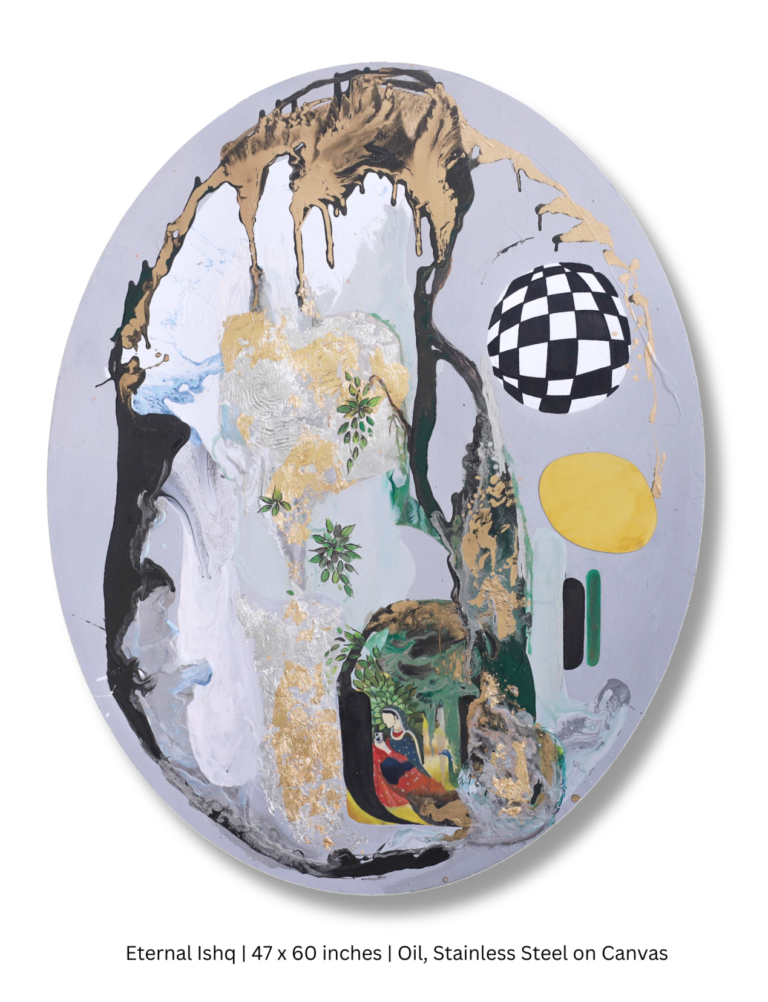
Particular drew inspiration from images and descriptions of Paradise allowing gardeners and urban planners to exercise their imagination as they attempted to replicate the otherworldly as a reflection of God’s Beauty, munificence and generosity in nature. Gardens marked land and territory; a chosen few could afford to enjoy leisure, romance and even intrigue within its confines. In South Asian poetry gardens can transform into spatial metaphors for change, youth, innocence and even revolution. Najm works with a consciousness of this history and its myriad contexts and coalesces it with her own journey as an artist who is a global traveler. Najm works and constantly lives, works and travels between New York and Lahore. Her idea of home then becomes transitory and transcultural. For instance in “Silent Seedlings” we see a bird’s eye view of a fragment of a building with trees and plants both inside and outside the building. With its graphic style resembling that of an illustration, the palette too appears to be almost artificial or unreal. It is lush, bright and hopeful. The atmosphere within this Lilliputian world is expectant. It is unclear where the stairs will lead or who will climb them but it is a

voyeuristic glimpse into another world or a portal of sorts which is at odds with the menacing silhouette of a dynamite bomb with an exploding wick in the lower corner. The warping of time and space is accentuated by the amorphous shape of her canvas which is a reflective surface that occupies most of the area surrounding the tiny portion of the architectural space. Such
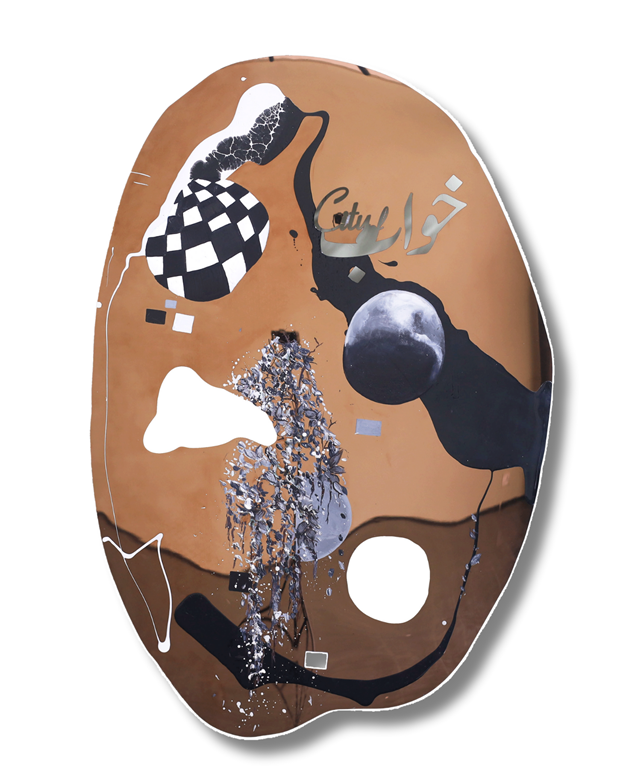
contradictions and parallel realities abound in Najm’s work and she constructs a world where dreams and risks, solution and dissolution vie for space on a single surface.
In “Resilient Roots” Najm uses the literary word for garden in Urdu, “Chaman” to capture a glimpse of the half-forgotten history and memory of her heritage. Najm explores the
constellation of meanings and associations that can be inferred from the placement of the visual and textual representation of “Chaman.” The viewer’s vantage point of the idyllic scene is hindered by the silhouette of a garden fence, its mirror surface glinting dangerously as it blocks an idyllic moment in a garden painted in the style of miniature painting done in the Polari School. Framed within an amorphous ” portal” Najm’s garden is evocative of a history, tradition and culture that seem to be within arm’s length but out of reach hence the wordplay and parentheses in the title. The painted area is represented in contrast to the use of industrial material as surface. Eschewing the fixed meanings assigned to the words “tradition” and “modernity” Najm recreates a vignette culled from a miniature painting onto a metal surface. She paints a gazebo with a doe eyed female sitting inside it surrounded by lush foliage. Much like the gardens of the past, the vast space outside the confines of the garden reflect the untamed and unpredictable reality of the world outside: as we gaze into this reflective void we question whether we should locate ourselves as purveyors or witnesses to the impenetrability of attaining this “Chaman” (Garden) that Najm seeks when she emblazons this word in Urdu in the top left corner?
Perhaps this concept of unattainability and inaccessibility is explored most effectively in what can best be described as one of Najm’s most powerful work in the exhibition. Najm translates the painterly image of a garden on a two dimensional surface into a three dimensional installation. A corner of the gallery space is demarcated by a square of actual green turf hemmed in by a fence on all sides. As one moves around the installation the tips of the fence glimmer with painted gold; their sharp ends are sleek and threatening as they point upwards . An old “payti” or trunk traditionally used to store w
Blankets and clothes mostly in rural areas are transformed into a precious object of desire: it lies open and reveals a metallic gold surface emblazoned with a verse of Mir Taqi Mir. Najm explains that the verse uses the garden as a metaphor “to remind us that our truest gardens flourish within, transient and untouched by the gardener’s hand and the garden within us.” Relating it to her work she explains that the interior of the trunk that emanates an almost divine light in gold is “a reflective surface where one contemplates what it means to own a piece of paradise and “sakoon”…how we mark our territories yet remain wanderers at heart, always yearning for the Spring of places we have called home whether in the bustling streets of Lahore or the steel forests of New York.”
Heartfelt desires, desperation, melancholy and wishful thinking can certainly conjure up fictional worlds and dreams that offer escapism to global citizens from the Global South.
A Harvard physicist Daniel Jefferis argued that even as early as 1916 when Einstein discovered general relativity, people had started thinking about tunnels in space that could allow one to connect to two different places. Since then there has been discussion and speculation about warp theory, black holes and even worm holes that have the ability to distort space-time through an effect known as gravitational time-dilation i.e. slowing down time. It is possible that even fiction such as Mohsin Hamid’s novel “Exit West” about migration and escape of migrants seeking refuge from a violent society through magical doors or “portals” is inspired by and explores these ideas. Perhaps one can equate Najm’s shapeless canvases and egg-like voids to similar magic doors and black holes. Through the use of distinct surfaces and spatial arrangements they challenge our perception of time and space. We confront ourselves in these surfaces, always morphing and remaining in flux much like Najm’s worldview and life. Yet we can never truly access the promise and magic contained within the various openings.
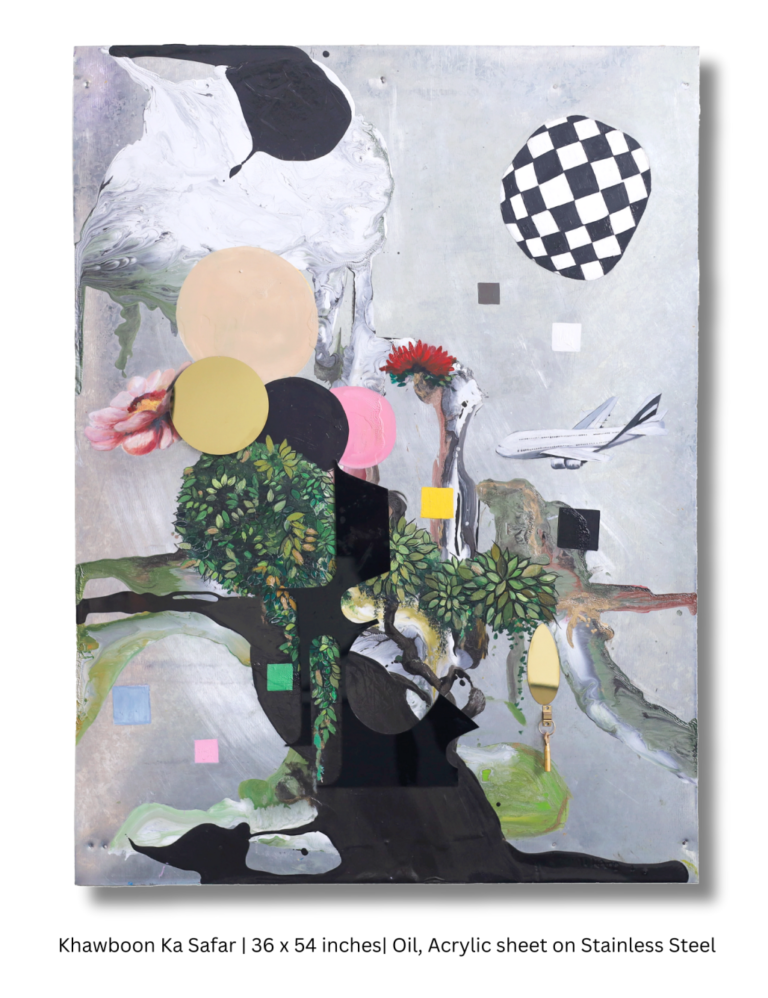
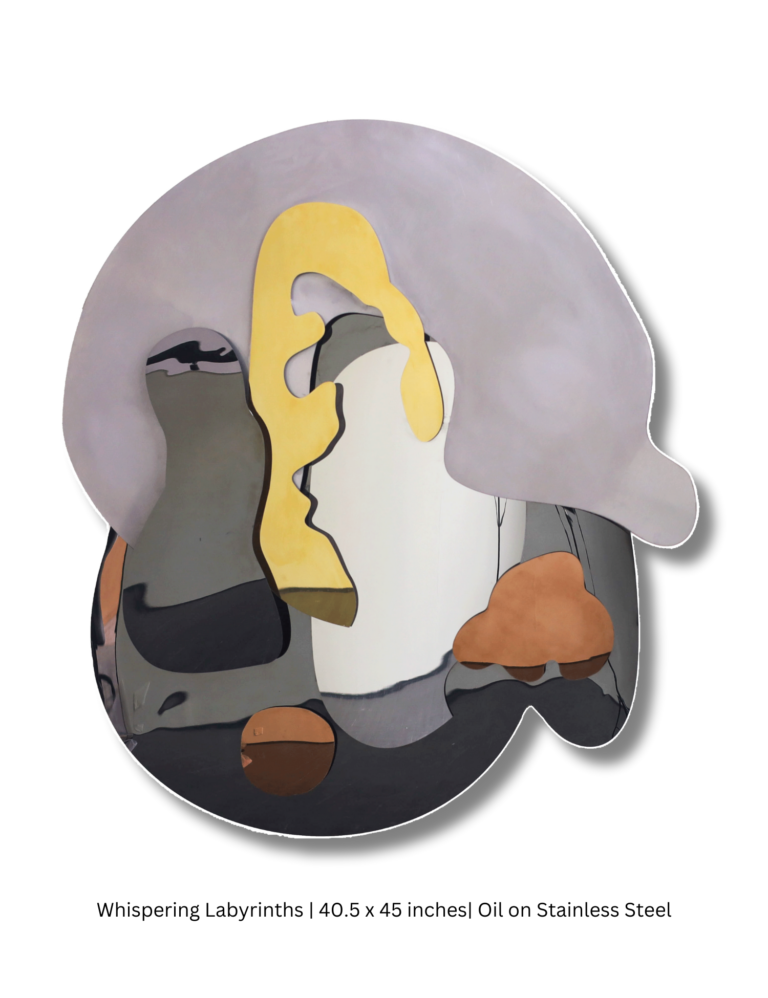
Writer’s Biography

Zohreen Murtaza
Zohreen Murtaza is a visual artist, writer/academic. Currently she is a Lecturer in the Cultural Studies Department at The National College of Arts, Lahore. She completed both her BFA and MA (Hons.) Visual Art from NCA. Since then Zohreen has branched into teaching, researching and writing extensively on Art. Her writings have been published regularly in Dawn newspaper (2017-2021). Her reviews have been published in Friday Times, Artnow, ADA Magazine and The Karachi Collective. Her writings have also appeared internationally in Canvas Magazine Dubai, TAKE on Art Magazine, India. Zohreen was the recipient of the Nigaah Art Award for Art Critic in 2022.

Zohreen Murtaza
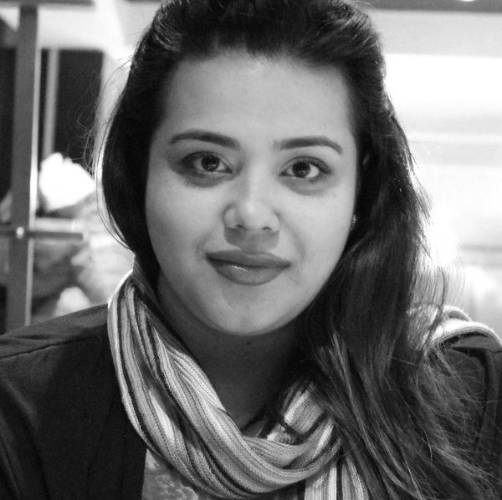
MARIAM HANIF KHAN
Visual Artist, Educator, Curator and Co- founder
Mariam Hanif is a Visual Artist based in Lahore, Pakistan. She received her BFA (hons.) and MA (hons.) degree in Visual Arts from renowned National College of Arts, Lahore. Mariam has been endowed...

MARIAM HANIF KHAN
Visual Artist, Educator, Curator and Co- founder
- Phone:+92 317 5111195
- Email:lahore.queries@artsoch.com

